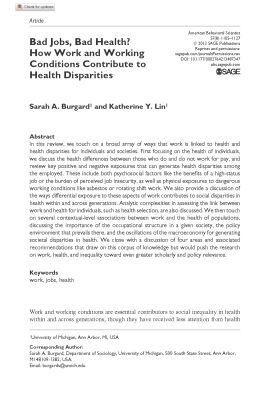Bad Jobs, Bad Health? How work and working conditions contribute to health disparities
This resource is available in English only.
In this must-read analysis, Burgard and Lin review primary and secondary studies to determine how work and health are linked. Bad Jobs, Bad Health contributes a seminal analysis about work and health and is a helpful resource for health and policy-based practitioners, researchers or students who wish to understand the basics of employment and work as determinants of health and health equity.
Burgard and Lin frame their analysis by describing the health-enhancing aspects of work and consider who has differential exposures to healthy work. As a contrast, they perform an in-depth description of the many physical and psychological ways that work can “get under the skin” to generate morbidity among individuals and populations. Here, Burgard and Lin explore the health equity impacts of hazardous work and employment throughout an individual’s life course, across generations, and differentially between social identities (ex. gender, race, age, immigration status). The fact that Burgard and Lin emphasize that the health-related impacts of work affect not only individual workers, but also their children and family, is a very relevant consideration for public health and primary care practitioners.
Another important contribution made by Burgard and Lin, is the clear connection made between structural factors and societal norms and the quality and quantity of jobs available in the labour market.
Epidemiologists and public health or policy researchers should take special interest in Burgard and Lin’s final analysis, where they outline four key implications for how research can be more relevant to shape policy that considers work and employment as powerful determinants of health and health equity.
Use this resource to:
- Understand the health-related impacts of work on individuals and populations
- Facilitate discussions about health equity impacts of hazardous work and employment throughout an individuals’ life course, across generations, and differentially between social identities (ex. gender, race, age, immigration status)
- Understand how structural factors and social norms contribute to the quality and quantities of jobs available in the labour market
Reference:
Burgard, S. A. et K. Y. Lin. (2013). Bad jobs, bad health? How work and working conditions contribute to health disparities. American Behavioral Scientist, 57(8), 1105-1127. https://doi.org/10.1177/0002764213487347
